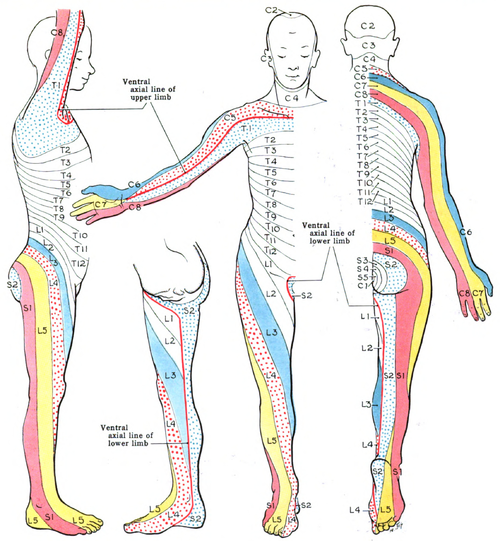Dermatomes: Difference between revisions
Anas Mohamed (talk | contribs) No edit summary |
Anas Mohamed (talk | contribs) No edit summary |
||
| Line 16: | Line 16: | ||
!'''Cervical''' | !'''Cervical''' | ||
! | ! | ||
|- | |- | ||
|C2 | |C2 | ||
Revision as of 10:01, 23 February 2020
Original Editor - Your name will be added here if you created the original content for this page.
Lead Editors
Dermatomes[edit | edit source]
A dermatome is an area of skin that is mainly supplied by a single spinal nerve. There are 8 cervical nerves (note C1 has with no dermatome), 12 thoracic nerves, 5 lumbar nerves and 5 sacral nerves. Each of these spinal nerves relay sensation from a particular region of the skin to the brain.[1]
The nerves from the upper cervical spine supply the skin of the neck. C5 to T1 nerves supply the arms. T2 to L2 nerves supply the chest and abdomen. L3 to S1 nerves supply the skin of the legs. S1-C1 nerves go to the groin.
| Nerve Root | Dermatomes |
|---|---|
| Cervical | |
| C2 | Temple, forehead, occiput |
| C3 | Entire neck, posterior cheek, temporal area, prolongation forward under mandible |
| C4 | Shoulder area, clavicular area, upper scapular area |
| C5 | Deltoid area, anterior aspect of entire arm to base of thumb |
| C6 | Anterior arm, radial side of hand to thumb and index finger |
| C7 | Lateral arm and forearm to index, long, and ring fingers |
| C8 | Medial arm and forearm to long, ring, and little fingers |
| Thoracic | |
| T1 | Medial side of forearm to base of little finger |
| T2 | Medial side of upper arm to medial elbow, pectoral and midscapular areas |
| T3-T12 | T3–T6, upper thorax;
T5–T7, costal margin; T8–T12, abdomen and lumbar region |
| Lumbar | |
| L1 | Back, over trochanter and groin |
| L2 | Back, front of thigh to knee |
| L3 | Back, upper buttock, anterior thigh and knee, medial lower leg |
| L4 | Medial buttock, latera thigh, medial leg, dorsum of foot, big toe |
| L5 | Buttock, posterior and lateral thigh, lateral aspect of leg, dorsum of foot, medial half of sole, first, second, and third toes |
| Sacral | |
| S1 | Buttock, thigh, and leg posterior |
| S2 | Same as S1 |
| S3 | Groin, medial thigh to knee |
| S4 | Perineum, genitals, lower sacrum |
Purpose[edit | edit source]
Testing of dermatomes is part of the neurological examination looking for radiculopathy as sensation changes within a specific dermatome may help in determining the pathological disc level.
Technique[edit | edit source]
Dermatome Testing is done ideally with a pin and cotton wool. Ask the patient to close their eyes and give the therapist feedback regarding the various stimuli. Testing should be done on specific dermatomes and should be compared to bilaterally.
Pinprick test (pain sensation) - Gently touches the skin with the pin ask the patient whether it feels sharp or blunt
Light touch test (light touch sensation) -Dab a piece of cotton wool on an area of skin [4]
References[edit | edit source]
- ↑ Wikipedia Dermatome. Available from: https://en.wikipedia.org/wiki/Dermatome_(anatomy) (last accessed 23.4.2019)
- ↑ M Roehrs. Dermatomes. Available from: https://www.youtube.com/watch?v=CYZBH6NX8wg&feature=youtu.be (last accessed 23.4.2019)
- ↑ David J. Magee. Orthopedic Physical Assessment. 6th edition. Elsevier. 2014.
- ↑ Slide share. Dermatomes and myotomes. Available from: https://www.slideshare.net/TafzzSailo/special-test-for-dermatomes-and-myotomes (last accessed 23.4.2019)







